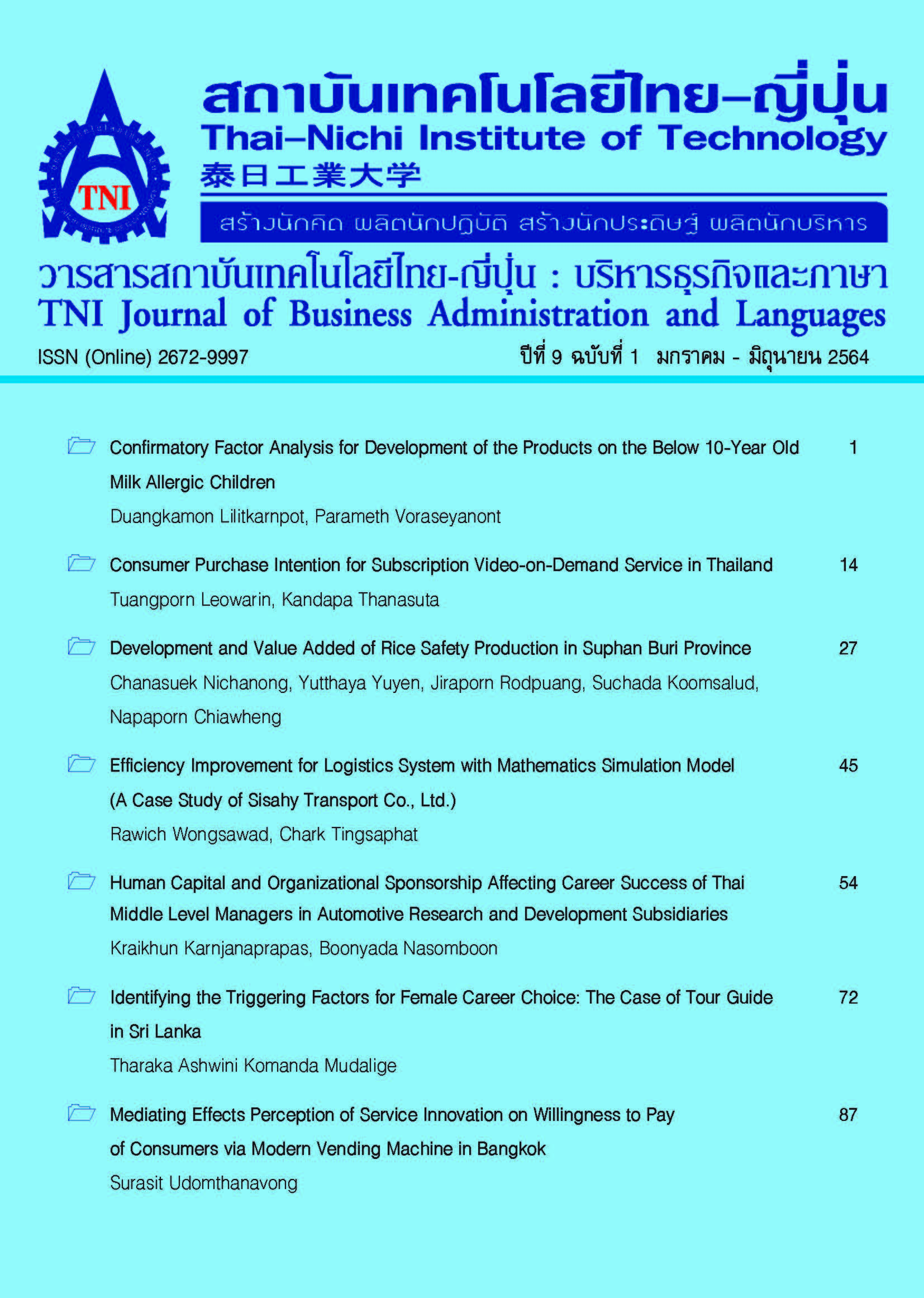การพัฒนาและเพิ่มมูลค่าการผลิตข้าวปลอดภัยในจังหวัดสุพรรณบุรี
Main Article Content
บทคัดย่อ
การพัฒนาและเพิ่มมูลค่าการผลิตข้าวปลอดภัยในจังหวัดสุพรรณบุรี เป็นโครงการวิจัยภายใต้ความร่วมมือระหว่างสำนักงานคณะกรรมการส่งเสริมวิทยาศาสตร์ วิจัยและนวัตกรรม (สกสว.) กับมหาวิทยาลัยสวนดุสิต โดยมีวัตถุประสงค์เพื่อพัฒนาและเพิ่มมูลค่าการผลิตข้าวปลอดภัยในจังหวัดสุพรรณบุรี ดำเนินการวิจัยในรูปแบบของการวิจัยเชิงปฏิบัติการแบบมีส่วนร่วม (Participate Action Research: PAR) ผ่านโครงการวิจัยย่อยที่อยู่ภายใต้โครงการวิจัยนี้จำนวน 13 โครงการ คัดเลือกกลุ่มเป้าหมายร่วมดำเนินงานแบบเจาะจง (Purposive Sampling) ได้แก่ กลุ่มเกษตรกร กลุ่มวิสาหกิจชุมชนผู้ปลูกข้าวในจังหวัดสุพรรณบุรี และตัวแทนหน่วยงานภาครัฐในพื้นที่ เก็บรวบรวมข้อมูลโดยใช้การจัดประชุมระดมสมอง (Brainstorming) การประชุมกลุ่ม (Focus Group Discussion: FGD) และการติดตามประเมินผลแบบเสริมพลัง (Empowerment Evaluation) วิเคราะห์ข้อมูลโดยใช้การสังเคราะห์เชิงคุณภาพ (Qualitative Synthesis)
จากการดำเนินงานวิจัยพบว่า สามารถเพิ่มมูลค่าการผลิตข้าวปลอดภัยในจังหวัดสุพรรณบุรี โดยแบ่งเป็นองค์ความรู้และนวัตกรรมการบริหารจัดการการผลิตข้าวปลอดภัย (ต้นน้ำ) ซึ่งได้แก่ องค์ความรู้ในการผลิตข้าวปลอดภัย ระบบสารสนเทศเชิงพื้นที่ ชุดตรวจสารเคมีปนเปื้อนในพื้นที่ปลูกข้าวอย่างง่าย นาโนแคลเซียมซิลิเกตจากวัสดุเหลือทิ้งทางการเกษตร และเครื่องตัดสับฟางข้าวแบบ ติดรถเกี่ยวนวดข้าว เกิดนวัตกรรมการแปรรูปข้าวและส่วนเหลือทิ้งจากการผลิตข้าว (กลางน้ำ) ได้แก่ ภาชนะอาหารจากฟางข้าว ผลิตภัณฑ์ข้าวพอง ผลิตภัณฑ์โจ๊กกึ่งสำเร็จรูป และน้ำส้มสายชูหมักจากข้าวปลอดภัย ตลอดจนเกิดการสร้างรูปแบบช่องทางการตลาด (ปลายน้ำ) ในลักษณะของการวิเคราะห์ห่วงโซ่อุปทานข้าวอินทรีย์ การท่องเที่ยวโดยการมีส่วนร่วมของชุมชน กิจการเพื่อสังคม และช่องทางการตลาดดิจิทัล เป็นต้น ทั้งนี้ ผลจากการดำเนินงานดังกล่าวสามารถเพิ่มมูลค่าการผลิตข้าวปลอดภัยในจังหวัดสุพรรณบุรีคิดเป็นมูลค่าประมาณ 41,460,000 บาท/ปี และมีเกษตรกร วิสาหกิจชุมชน ผู้ประกอบการ และหน่วยงานภาครัฐในพื้นที่ที่ได้รับผลกระทบจำนวน 1,235 คน
Article Details
นโยบายการรับบทความ
กองบรรณาธิการวารสารสถาบันเทคโนโลยีไทย-ญี่ปุ่น มีความยินดีรับบทความจากอาจารย์ นักศึกษา และผู้ทรงคุณวุฒิในสาขาบริหารธุรกิจและภาษา ที่เขียนเป็นภาษาไทยหรือภาษาอังกฤษ ซึ่งผลงานวิชาการที่ส่งมาขอตีพิมพ์ต้องไม่เคยเผยแพร่ในสิ่งพิมพ์อื่นใดมาก่อน และต้องไม่อยู่ในระหว่างการพิจารณาของวารสารอื่นที่นำส่ง ดังนั้นผู้สนใจที่จะร่วมเผยแพร่ผลงานและความรู้ที่ศึกษามาสามารถนำส่งบทความได้ที่กองบรรณาธิการเพื่อเสนอต่อคณะกรรมการกลั่นกรองบทความพิจารณาจัดพิมพ์ในวารสารต่อไป ทั้งนี้บทความที่สามารถเผยแพร่ได้ประกอบด้วยบทความวิจัย ผู้สนใจสามารถศึกษาและจัดเตรียมบทความจากคำแนะนำสำหรับผู้เขียนบทความ
การละเมิดลิขสิทธิ์ถือเป็นความรับผิดชอบของผู้ส่งบทความโดยตรง บทความที่ได้รับการตีพิมพ์ต้องผ่านการพิจารณากลั่นกรองคุณภาพจากผู้ทรงคุณวุฒิและได้รับความเห็นชอบจาก กองบรรณาธิการ
ข้อความที่ปรากฏภายในบทความของแต่ละบทความที่ตีพิมพ์ในวารสารวิชาการเล่มนี้ เป็น ความคิดเห็นส่วนตัวของผู้เขียนแต่ละท่าน ไม่เกี่ยวข้องกับสถาบันเทคโนโลยีไทย-ญี่ปุ่น และคณาจารย์ท่านอื่น ๆ ในสถาบัน แต่อย่างใด ความรับผิดชอบด้านเนื้อหาและการตรวจร่างบทความแต่ละบทความเป็นของผู้เขียนแต่ละท่าน หากมีความผิดพลาดใด ๆ ผู้เขียนแต่ละท่านจะต้องรับผิดชอบบทความของตนเองแต่ผู้เดียว
กองบรรณาธิการขอสงวนสิทธิ์มิให้นำเนื้อหา ทัศนะ หรือข้อคิดเห็นใด ๆ ของบทความในวารสารวิชาการ สถาบันเทคโนโลยีไทย-ญี่ปุ่น ไปเผยแพร่ก่อนได้รับอนุญาตจากผู้นิพนธ์อย่างเป็นลายลักษณ์อักษร ผลงานที่ได้รับการตีพิมพ์ถือเป็นลิขสิทธิ์ของวารสารสถาบันเทคโนโลยีไทย-ญี่ปุ่น
หากต้องการสอบถามข้อมูลเพิ่มเติมที่
- กองบรรณาธิการ วารสารสถาบันเทคโนโลยีไทย-ญี่ปุ่น
- ฝ่ายวิจัยและนวัตกรรม สถาบันเทคโนโลยีไทย-ญี่ปุ่น
เลขที่ 1771/1 สถาบันเทคโนโลยีไทย-ญี่ปุ่น ซอยพัฒนาการ 37-39 ถนนพัฒนาการ แขวงสวนหลวง เขตสวนหลวง กรุงเทพมหานคร 10250 ติดต่อกับคุณพิมพ์รต พิพัฒนกุล (02) 763-2752 , คุณอาริสา จิระเวชถาวร (02) 763-2600 Ext. 2704 Fax. (02) 763-2754 หรือ E-mail: JBAL@tni.ac.th
เอกสารอ้างอิง
Boonmasongsung, D. T., Rodpon, P., Vasupen, K., Wongsorn, D., Doosanthia, N., Montee, A., & Pianpumepong, P. (2019). Community participation in adding value in Rajamangala Isan Village’s rice paddy seeds: Ban Sala, Nakorn Ratchasima Province (in Thai). Area Based Development Research Journal, 11(4), 305–317.
Boonnin, T., Boonbrahm, N., Amaritsut, W., & Sathonwisit T. (2011, August). Agricultural production information system (in Thai). The 7th National Agricultural System Symposium. Symposium conducted at the meeting of Taksila Hotel, Maha Sarakham, Thailand.
Chaowagul, M. (2011). Revision of rice market structure of Thailand (Research report) (in Thai). Bangkok: The Thailand Research Fund.
Charoensuk, N. (2016). Effectiveness of safety training program in pesticides utilization of farmer in Donchedi District, Suphanburi Province (in Thai). Naresuan University Journal: Science and Technology (NUJST), 24(1), 91–101.
Gilson, L. (2014). Qualitative research synthesis for health policy analysis: what does it entail and what does it offer?. Health Policy and Planning, 29(3), iii1–iii5.
Hitchcock, H. R., & Johnson, P. (1997). The international style. New York: WW Norton & Company.
Jaima, W., Chaiyanon, P., & Leetrakun, P. (2018). Comparison of cost and benefit between organic rice farming and chemical rice farming: A case study in sufficiency economy community, Ban Dok-bua, Phayao Province (in Thai). Journal of Graduate Studies in Northern Rajabhat Universities, 8(14), 73–86.
Jongmeesuk, T., Tossamas, P., & Worapreda, P. (2017). Strategy analysisof Thai rice development and processing and competition in world trade market (in Thai). Journal of Research and Development Institute, Rajabhat Maha Sarakham University, 4(2), 13–26.
Khumsoonthorn, J., Kaengkun, P., & Srisaard, K. (2017). Study on Jasmine Rice production problem for being certified with GAP standard in Yasothon Province (in Thai). Prawarun Agricultural Journal, 14(1), 82–94.
McIntosh, R. W., & Goeldner, C. R. (2009). Tourism principle, practices and philosophies (11th ed.). New Jersey: John Wiley & Sons.
Nimanong, K. (2016). A study of process supporting community based research for strengthen the community of node maeklong through work by reinforcement mechanisms. (in Thai). (Master's thesis). Thammasat University, Bangkok, Thailand.
Oupkeaw, P., Jankangram, W., & Charoensook, R. (2018). The conservation and increase value of local rice in provinces regions border with Cambodia (in Thai). Chonburi: Burapha University.
Pattana, R. (2020). Guidelines for product development to increase rice value of Ban Krang Subdistrict, Muang District, Phitsanulok Province (in Thai). Valaya Alongkorn Review, 10(3), 89–99.
Praphatpong, S. (2020). Management guidelines to reduce costs and increase productivity by applying information technology to increase the market competitiveness of Jasmine Rice in Sisaket Province (in Thai). Journal of Management Science Review, 22(1), 169–182.
Saengsanga, T., & Rattana, T. (2018). A case study of Krabuang yai sub-district, Phimai district, Nakhon Ratchasima (in Thai). Academic Journal: Uttaradit Rajabhat University, 13(2), 53–63. Retrieved from https://ph01.tci-thaijo.org/index.php/uruj/article/download/139283/111259.
Sakdee, A. (2010). Design and development the furniture product straw from padder fied (in Thai). Industry Technology Lampang Rajabhat University, 3(1), 1–10.
Sangkaman, S. (2016). Value creation for processed rice products: A case study of Yasothon Province (in Thai). Bangkok: Chulalongkorn University Social Research Institute.
Schnoes, C. J., Murphy-Berman, V., & Chambers, J. M. (2000). Empowerment evaluation applied: Experiences, analysis, and recommendations from a case study. The American Journal of Evaluation, 21(1), 53–64.
Sinthusiri, N., Inthasang, C., Boonmasongsung, D. T., Nunnad, P., & Thongpracha, K. (2020). Distribution channel of organic rice processed product: Case study of Nakornkong Jasmine Rice community enterprises, Nakhon Ratchasima Province (in Thai). Academic Journal of Humanities and Social Sciences Burapha University, 28(2), 82–107.
Suphan Buri Provincial Agriculture and Cooperatives Office. (2020). Information on agriculture and cooperatives of Suphan Buri Province (2020) (in Thai). Suphan Buri Provincial Agriculture and Cooperatives Office: Suphan Buri, Thailand.
Suphan Buri Provincial Agricultural Extension Office. (2017). Suitable rice cultivation area map. Retrieved from http://www.suphanburi.doae.go.th/Data(agri)2.html
Suphan Buri Provincial Statistical Office. (2015). Suphan Buri Province development plan (2015-2018) (in Thai). Suphan Buri Provincial Statistical Office: Suphan Buri, Thailand.
Thong-on, W. (2017). Increasing cassava yield by research knowledge synthesis, community communication, and geographic information systems in Kamphaeng Phet Province Areas (in Thai). Journal of Community Development and Life Quality, 4(1), 122–136.
Trakoolchokumnuay, K. (2015). Innovation of rice production, rice processing, and rice trade in Thailand (in Thai). Journal of Social Development, 17(2), 51–68.
Wandersman, A., Alia, K. A., Cook, B., & Ramaswamy, R. (2015). Integrating empowerment evaluation and quality improvement to achieve healthcare improvement outcomes. BMJ Quality & Safety, 24(10), 645–652.
Yin, H., Zhao, W., Li, T., Cheng, X., & Liu, Q. (2018). Balancing straw returning and chemical fertilizers in China: Role of straw nutrient resources. Renewable and Sustainable Energy Reviews, 81(P2), 2695–2702.


